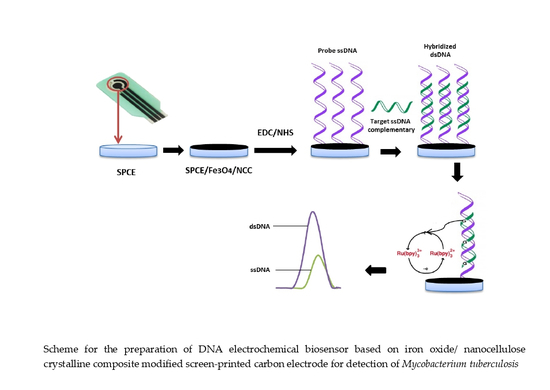DNA Electrochemical Biosensor Based on Iron Oxide/Nanocellulose Crystalline Composite Modified Screen-Printed Carbon Electrode for Detection of Mycobacterium tuberculosis
Abstract
:1. Introduction
2. Results
2.1. The Field Emission Scanning Electron Microscopy (FESEM) Analysis
2.2. Electrochemical Characterization
2.3. Electrochemical Performance of Fabricating Electrochemical DNA Biosensor
2.4. Selectivity and Sensitivity of the Developed Electrochemical DNA Sensor
2.5. Detection of PCR Product of Mycobacterium Tuberculosis
3. Discussion
3.1. The Field Emission Scanning Electron Microscopy (FESEM) Analysis
3.2. Electrochemical Characterization
3.3. Electrochemical Performance of Fabricating Electrochemical DNA Biosensor
3.4. Selectivity and Sensitivity of the Developed Electrochemical DNA Sensor
3.5. Detection of PCR Product of Mycobacterium Tuberculosis
4. Materials and Methods
4.1. Reagents
4.2. Real Sample Application
4.3. Preparations of Stock Solutions
4.4. Instrumentation
4.5. Preparation of MPA-Fe3O4
4.6. Preparation of NCC/CTAB
4.7. Preparation of MPA-Fe3O4/Ncc/Ctab
4.8. Immobilization of DNA Probe onto Modified SPCE/MPA-Fe3O4/Ncc/Ctab
4.9. Hybridization of DNA
5. Conclusions
Author Contributions
Funding
Acknowledgments
Conflicts of Interest
References
- Ryndak, M.B.; Laal, S. Mycobacterium tuberculosis Primary Infection and Dissemination: A Critical Role for Alveolar Epithelial Cells. Front. Cell. Infect. Microbiol. 2019, 9, 299. [Google Scholar] [CrossRef] [PubMed]
- World Health Organization (WHO). The WHO global TB database in Global Tuberculosis Report 2019. 2019. Available online: https://www.who.int/tb/publications/global_report/en/ (accessed on 17 October 2019).
- Taxonera, C.; Ponferrada, A.; Riestra, S.; Bermejo, F.; Saro, C.; Martin-Arranz, M.D.; Cabriada, J.L.; Barreiro-de Acosta, M.; de Castro, M.L.; Lopez-Serrano, P.; et al. Serial Tuberculin Skin Tests Improve the Detection of Latent Tuberculosis Infection in Patients With Inflammatory Bowel Disease. J. Crohns. Colitis 2018, 12, 1270–1279. [Google Scholar] [CrossRef] [PubMed]
- Nayak, S.; Acharjya, B. Mantoux test and its interpretation. Indian Dermatol. 2012, 3, 2–6. [Google Scholar] [CrossRef]
- Jaeger, S.; Karargyris, A.; Candemir, S.; Siegelman, J.; Folio, L.; Antani, S.; Thoma, G. Automatic Screening for Tuberculosis in Chest Radiographs: A Survey. Quant. Imaging Med. Surg. 2013, 3, 89–99. [Google Scholar]
- Pokam, B.T.; Asuquo, A.E. Acid-Fast Bacilli Other than Mycobacteria in Tuberculosis Patients Receiving Directly Observed Therapy Short Course in Cross River State, Nigeria. Tuberc. Res. Treat. 2012, 2012, 301056. [Google Scholar] [CrossRef] [PubMed] [Green Version]
- Dunn, J.J.; Starke, J.R.; Revell, P.A. Laboratory Diagnosis of Mycobacterium tuberculosis Infection and Disease in Children. J. Clin. Microbiol. 2016, 54, 1434–1441. [Google Scholar] [CrossRef] [Green Version]
- Parsons, L.M.; Somoskovi, A.; Gutierrez, C.; Lee, E.; Paramasivan, C.N.; Abimiku, A.; Spector, S.; Roscigno, G.; Nkengasong, J. Laboratory Diagnosis of Tuberculosis in Resource-Poor Countries: Challenges and Opportunities. Clin. Microbiol. Rev. 2011, 24, 314–350. [Google Scholar] [CrossRef] [Green Version]
- Fakruddin, M.; Mannan, K.S.; Chowdhury, A.; Mazumdar, R.M.; Hossain, M.N.; Islam, S.; Chowdhury, M.A. Nucleic acid amplification: Alternative methods of polymerase chain reaction. J. Pharm. Bioallied Sci. 2013, 5, 245–252. [Google Scholar] [CrossRef]
- Noviana, E.; McCord, C.P.; Clark, K.M.; Jang, I.; Henry, C.S. Electrochemical paper-based devices: Sensing approaches and progress toward practical applications. Lab. Chip. 2020, 20, 9–34. [Google Scholar] [CrossRef]
- Kimmel, D.W.; LeBlanc, G.; Meschievitz, M.E.; Cliffel, D.E. Electrochemical Sensors and Biosensors. Anal. Chem. 2012, 84, 685–707. [Google Scholar] [CrossRef] [Green Version]
- Maduraiveeran, G.; Sasidharan, M.; Ganesan, V. Electrochemical sensor and biosensor platforms based on advanced nanomaterials for biological and biomedical applications. Biosens. Bioelectron. 2018, 103, 113–129. [Google Scholar] [CrossRef] [PubMed]
- Qi, H.; Li, X.; Chen, P.; Zhang, C. Electrochemical detection of DNA hybridization based on polypyrrole/ss-DNA/multi-wall carbon nanotubes paste electrode. Talanta 2007, 72, 1030–1035. [Google Scholar] [CrossRef] [PubMed]
- Abu-Salah, K.M.; Zourob, M.M.; Mouffouk, F.; Alrokayan, S.A.; Alaamery, M.A.; Ansari, A.A. DNA-Based Nanobiosensors as an Emerging Platform for Detection of Disease. Sensors 2015, 15, 14539–14568. [Google Scholar] [CrossRef] [PubMed] [Green Version]
- Zhang, S.; Ding, Y.; Wei, H. Ruthenium Polypyridine Complexes Combined with Oligonucleotides for Bioanalysis: A Review. Molecules 2014, 19, 11933–11987. [Google Scholar] [CrossRef]
- Dutse, S.W.; Yusof, N.A.; Ahmad, H.; Zainal, M.Z.H.Z. An Electrochemical DNA Biosensor for Ganoderma boninense Pathogen of the Oil Palm Utilizing a New Ruthenium Complex, [Ru(dppz)2(qtpy)]Cl2. Int. J. Electrochem. Sci. 2012, 7, 8105–8115. [Google Scholar]
- Krishnan, S.K.; Singh, E.; Singh, P.; Meyyappan, M.; Nalwa, H.S. A review on graphene-based nanocomposites for electrochemical and fluorescent biosensors. RSC Adv. 2019, 9, 8778–8881. [Google Scholar] [CrossRef]
- Mat Zaid, M.H.; Abdullah, J.; Yusof, N.A.; Wasoh, H.; Sulaiman, Y.; Md Noh, M.F.; Issa, R. PNA biosensor based on reduced graphene oxide/water soluble quantum dots for the detection of Mycobacterium tuberculosis. Sens. Actuators B-Chem. 2017, 241, 1024–1034. [Google Scholar] [CrossRef]
- Khan, I.; Saeed, K.; Khan, I. Nanoparticles: Properties, applications and toxicities. Arab. J. Chem. 2019, 12, 908–931. [Google Scholar] [CrossRef]
- Lin, P.H.; Li, B.R. Antifouling strategies in advanced electrochemical sensors and biosensors. Analyst 2020, 145, 1110–1120. [Google Scholar] [CrossRef]
- Arani, N.H.; Ghoreishi, S.M.; Khoobi, A. Increasing the electrochemical system performance using a magnetic nanostructured sensor for simultaneous determination of l-tyrosine and epinephrine. Anal. Methods. 2019, 11, 1192–1198. [Google Scholar] [CrossRef]
- Zhang, W.; Li, X.; Zou, R.; Wu, H.; Shi, H.; Yu, S.; Liu, Y. Multifunctional glucose biosensors from Fe3O4 nanoparticles modified chitosan/graphene nanocomposites. Sci. Rep. 2015, 5, 11129. [Google Scholar] [CrossRef] [PubMed] [Green Version]
- Xu, J.-K.; Zhang, F.-F.; Sun, J.-J.; Sheng, J.; Wang, F.; Sun, M. Bio and Nanomaterials Based on Fe3O4. Molecules 2014, 19, 21506–21528. [Google Scholar] [CrossRef] [PubMed]
- Dumanli, A.G. Nanocellulose and its Composites for Biomedical Applications. Curr. Med. Chem. 2017, 24, 512–528. [Google Scholar] [CrossRef] [PubMed]
- Trache, D.; Tarchoun, A.F.; Derradji, M.; Hamidon, T.S.; Masruchin, N.; Brosse, N.; Hussin, M.H. Nanocellulose: From Fundamentals to Advanced Applications. Front Chem. 2020, 8, 392. [Google Scholar] [CrossRef]
- Esmaeili, C.; Abdi, M.M.; Mathew, A.P.; Jonoobi, M.; Oksman, K.; Rezay, M. Synergy Effect of Nanocrystalline Cellulose for the Biosensing Detection of Glucose. Sensors 2015, 15, 24681–24697. [Google Scholar] [CrossRef] [Green Version]
- Zaid, M.H.M.; Abdullah, J.; Yusof, N.A.; Wasoh, H.; Sulaiman, Y.; Noh, M.F.M.; Issa, R. Reduced Graphene Oxide/TEMPO-Nanocellulose Nanohybrid-Based Electrochemical Biosensor for the Determination of Mycobacterium tuberculosis. J. Sens. 2020, 2020. [Google Scholar] [CrossRef] [Green Version]
- Mahmoud, K.A.; Male, K.B.; Hrapovic, S.; Luong, J.H.T. Cellulose Nanocrystal/Gold Nanoparticle Composite as a Matrix for Enzyme Immobilization. ACS Appl. Mater. Interfaces 2009, 1, 1383–1386. [Google Scholar] [CrossRef]
- Kedzior, S.A.; Dubé, M.E.; Cranston, E.D. Tailoring Cellulose Nanocrystal and Surfactant Behavior in Miniemulsion Polymerization. Macromolecules 2017, 50, 2645–2655. [Google Scholar] [CrossRef]
- Mohamad, F.S.; Mat Zaid, M.H.; Abdullah, J.; Zawawi, R.M.; Lim, H.N.; Sulaiman, Y.; Rahman, N.A. Synthesis and Characterization of Polyaniline/Graphene Composite Nanofiber and its Application as an Electrochemical DNA Biosensor for the Detection of Mycobacterium tuberculosis. Sensors 2017, 17, 2789. [Google Scholar] [CrossRef] [Green Version]
- Mohd Azmi, U.Z.; Yusof, N.A.; Kusnin, N.; Abdullah, J.; Suraiya, S.; Ong, P.S.; Ahmad Raston, N.H.; Abd Rahman, S.F.; Mohamad Fathil, M.F. Sandwich Electrochemical Immunosensor for Early Detection of Tuberculosis Based on Graphene/Polyaniline-Modified Screen-Printed Gold Electrode. Sensors 2018, 18, 3926. [Google Scholar] [CrossRef] [Green Version]
- Mohd Bakhori, N.; Yusof, N.A.; Abdullah, J.; Wasoh, H.; Ab Rahman, S.K.; Abd Rahman, S.F. Surface Enhanced CdSe/ZnS QD/SiNP Electrochemical Immunosensor for the Detection of Mycobacterium tuberculosis by Combination of CFP10-ESAT6 for Better Diagnostic Specificity. Materials 2019, 13, 149. [Google Scholar] [CrossRef] [PubMed] [Green Version]
- Chieng, B.W.; Lee, S.H.; Ibrahim, N.A.; Then, Y.Y.; Loo, Y.Y. Isolation and Characterization of Cellulose Nanocrystals from Oil Palm Mesocarp Fiber. Polymers 2017, 9, 355. [Google Scholar] [CrossRef]
- Sirivat, A.; Paradee, N. Facile synthesis of gelatin-coated Fe3O4 nanoparticle: Effect of pH in Single-step Co-precipitation for Cancer Drug Loading. Mater. Design 2019, 181, 107942. [Google Scholar] [CrossRef]
- Wang, H.W.; Lin, H.C.; Yeh, Y.C. Synthesis of Fe3O4 Nanowire Arrays Via Precipitation in Templates and Microwave Hydrothermal Process. Int. J. Appl. Ceram. Tec. 2009, 7, 33–38. [Google Scholar] [CrossRef]
- Rashid, J.I.A.; Yusof, N.A. The strategies of DNA immobilization and hybridization detection mechanism in the construction of electrochemical DNA sensor: A review. Sens. Biosensing Res. 2017, 16, 19–31. [Google Scholar] [CrossRef]
- Siljander, S.; Keinanen, P.; Raty, A.; Ramakrishnan, K.R.; Tuukkanen, S.; Kunnari, V.; Harlin, A.; Vuorinen, J.; Kanerva, M. Effect of Surfactant Type and Sonication Energy on the Electrical Conductivity Properties of Nanocellulose-CNT Nanocomposite Films. Int. J. Mol. Sci. 2018, 19, 1819. [Google Scholar] [CrossRef] [Green Version]
- García-Miranda, F.A.; Foster, C.W.; Kelly, P.J.; Brownson, D.A.C.; Banks, C.E. Determination of the Electrochemical Area of Screen-Printed Electrochemical Sensing Platforms. Biosensors 2018, 8, 53. [Google Scholar] [CrossRef] [Green Version]
- Thomas, D.; Rasheed, Z.; Jagan, J.S.; Kumar, K.G. Study of kinetic parameters and development of a voltammetric sensor for the determination of butylated hydroxyanisole (BHA) in oil samples. J. Food Sci. Technol. 2015, 52, 6719–6726. [Google Scholar] [CrossRef] [Green Version]
- Seeber, R.; Zanardi, C.; Inzelt, G. The inherent coupling of charge transfer and mass transport processes: The curious electrochemical reversibility. Chem. Texts 2016, 2, 8. [Google Scholar] [CrossRef] [Green Version]
- Pages, B.J.; Ang, D.L.; Wright, E.P.; Aldrich-Wright, J.R. Metal complex interactions with DNA. Dalton Trans. 2015, 44, 3505–3526. [Google Scholar] [CrossRef]
- Shahabadi, N.; Mohammadi, S. Synthesis Characterization and DNA Interaction Studies of a New Zn(II) Complex Containing Different Dinitrogen Aromatic Ligands. Bioinorg. Chem Appl. 2012, 2012, 571913. [Google Scholar] [CrossRef] [PubMed]
- Venkateswarlu, S.; Himagirish Kumar, S.H.; Jyothi, N.V.V. Rapid removal of Ni (II) from aqueous solution using 3-Mercaptopropionic acid functionalized bio magnetite nanoparticles. Water Resour. Ind. 2015, 12, 1–7. [Google Scholar] [CrossRef] [Green Version]
MTB samples are available only with permission from the ethical community of university Putra Malaysia (UPM) and Institute for Medical Research, Malaysia (IMR). |
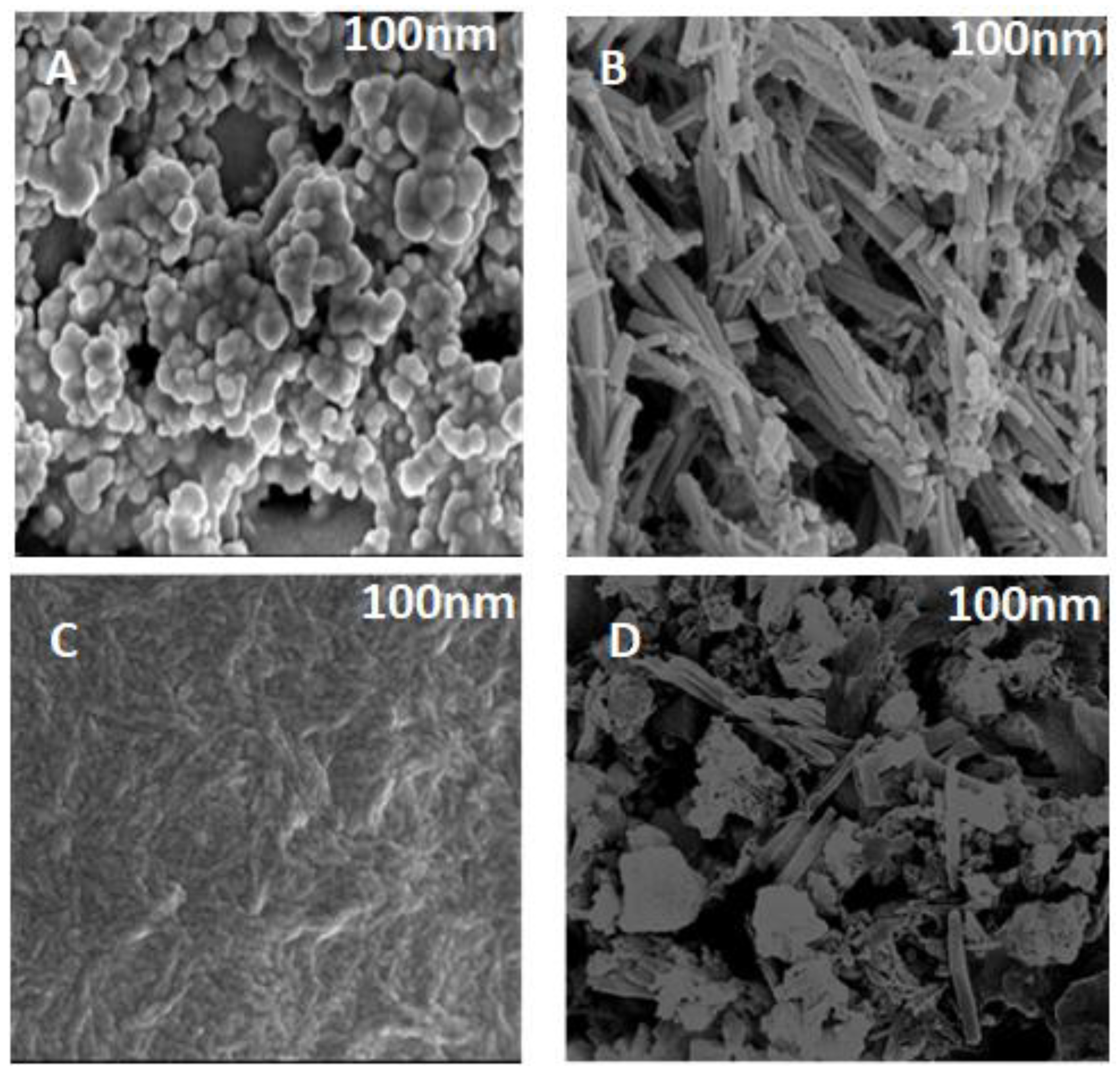

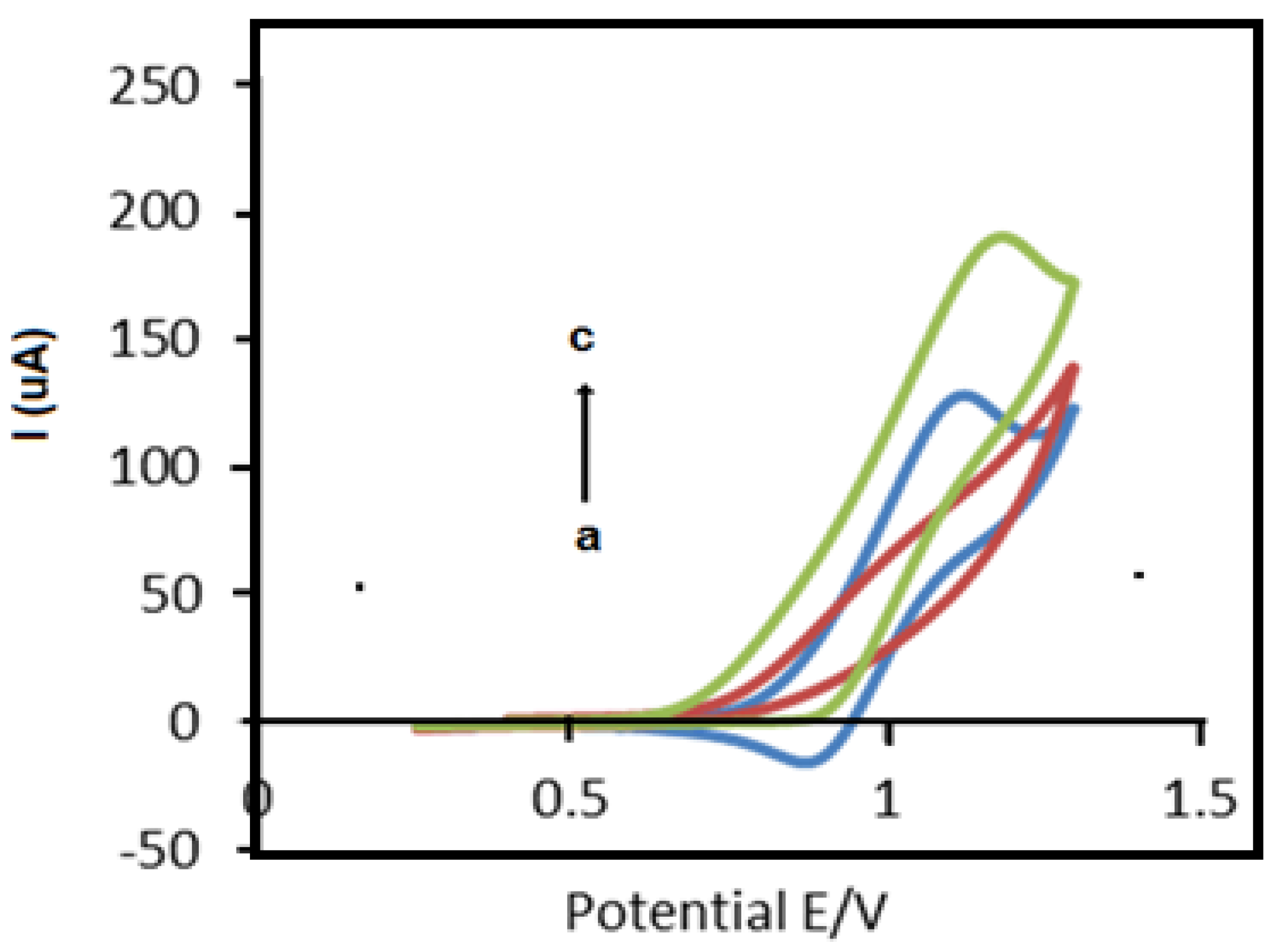

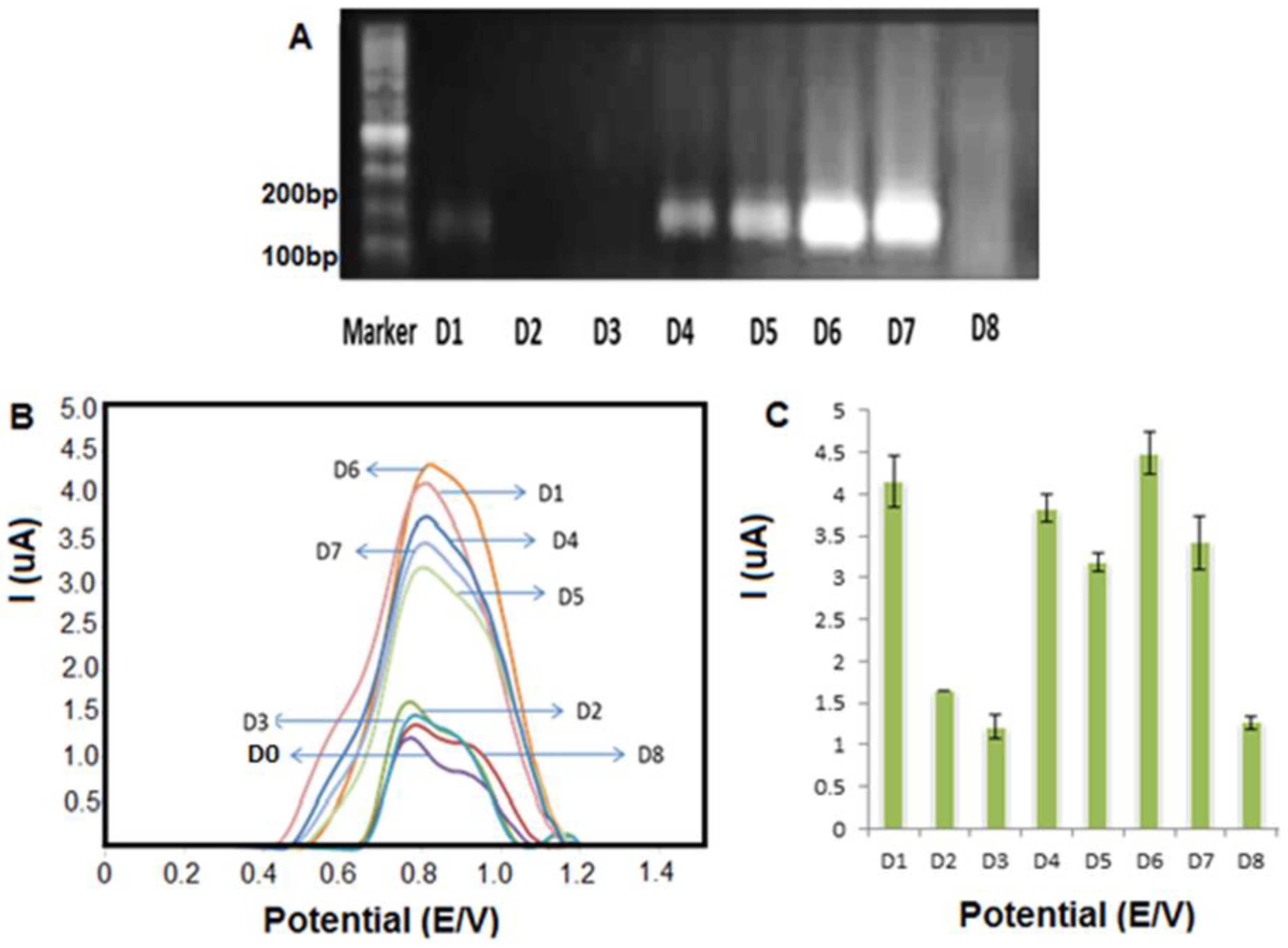
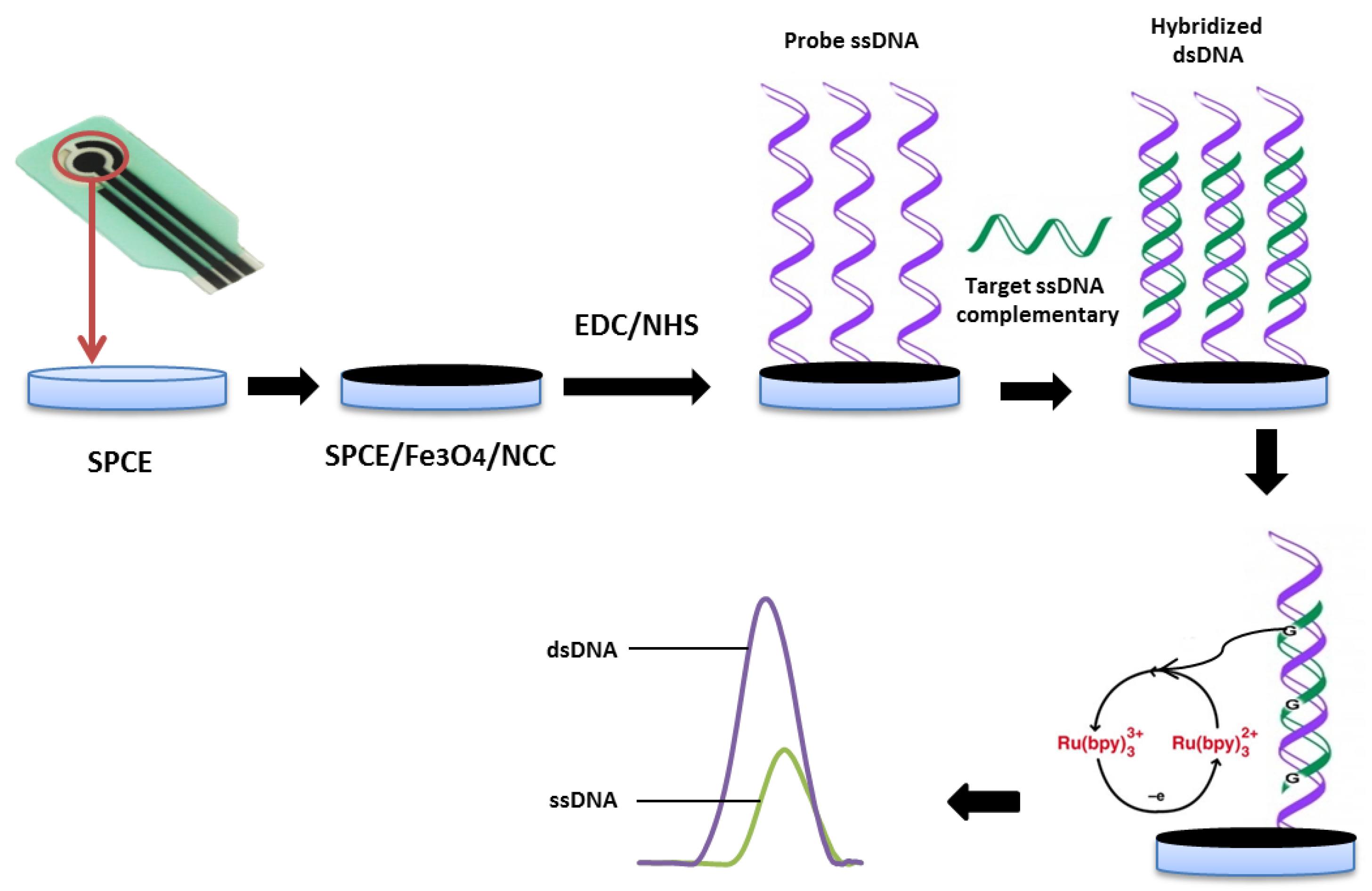
| Nanomaterial 1 | Bio- Molecule | Inter- Calator | Limit of Detection | Real Sample | Reference |
|---|---|---|---|---|---|
| Gr/ppy/SPCE | DNA | MB | 7.8 × 10−7 M | No | [30] |
| RGO/TNCC/SPCE | PNA | MB | 1 × 10−13 M | Yes | [25] |
| Gr/ppy/SPG | Antibody | - | 5 ng/mL | Yes | [31] |
| CdSe/ZnS QD/SiNP/SPCE | Antibody | H2O2 | 1.5 × 10−10 g/mL | No | [32] |
| MPA-Fe2O3/NCC/CTAB/SPCE | DNA | Ru(bpy)32+ | 7.96 × 10−13 M | Yes | This work |
| Name of the DNA Strand | DNA Sequences |
|---|---|
| Amine Probe DNA | 5′-/5AmMC12/CTC GTC CAG CGC CGC TTC GG-3′ |
| Target DNA | 5′-CCG AAG CGG CGC TGG ACG AG-3′ |
| non-complementary DNA | 5′-TTT GGT ATT ATT GTT CAT GT-3′ |
| Mutation DNA | 5′-CTC GTC CAG CGC CIC TTC GG-3′ |
| Primer MTB Forward | 5′-CGT GAG GGC ATC GAG GTG GC-3′ |
| Primer MTB Reverse | 5′-GCG TAG GCG TCG GTG ACG AA-3′ |
© 2020 by the authors. Licensee MDPI, Basel, Switzerland. This article is an open access article distributed under the terms and conditions of the Creative Commons Attribution (CC BY) license (http://creativecommons.org/licenses/by/4.0/).
Share and Cite
Mat Zaid, M.H.; Che-Engku-Chik, C.E.N.; Yusof, N.A.; Abdullah, J.; Othman, S.S.; Issa, R.; Md Noh, M.F.; Wasoh, H. DNA Electrochemical Biosensor Based on Iron Oxide/Nanocellulose Crystalline Composite Modified Screen-Printed Carbon Electrode for Detection of Mycobacterium tuberculosis. Molecules 2020, 25, 3373. https://doi.org/10.3390/molecules25153373
Mat Zaid MH, Che-Engku-Chik CEN, Yusof NA, Abdullah J, Othman SS, Issa R, Md Noh MF, Wasoh H. DNA Electrochemical Biosensor Based on Iron Oxide/Nanocellulose Crystalline Composite Modified Screen-Printed Carbon Electrode for Detection of Mycobacterium tuberculosis. Molecules. 2020; 25(15):3373. https://doi.org/10.3390/molecules25153373
Chicago/Turabian StyleMat Zaid, Mohd Hazani, Che Engku Noramalina Che-Engku-Chik, Nor Azah Yusof, Jaafar Abdullah, Siti Sarah Othman, Rahizan Issa, Mohd Fairulnizal Md Noh, and Helmi Wasoh. 2020. "DNA Electrochemical Biosensor Based on Iron Oxide/Nanocellulose Crystalline Composite Modified Screen-Printed Carbon Electrode for Detection of Mycobacterium tuberculosis" Molecules 25, no. 15: 3373. https://doi.org/10.3390/molecules25153373





